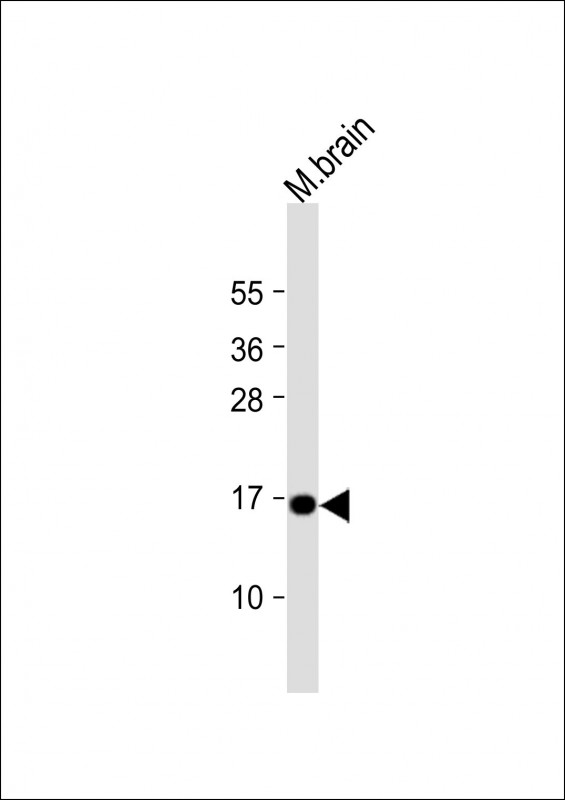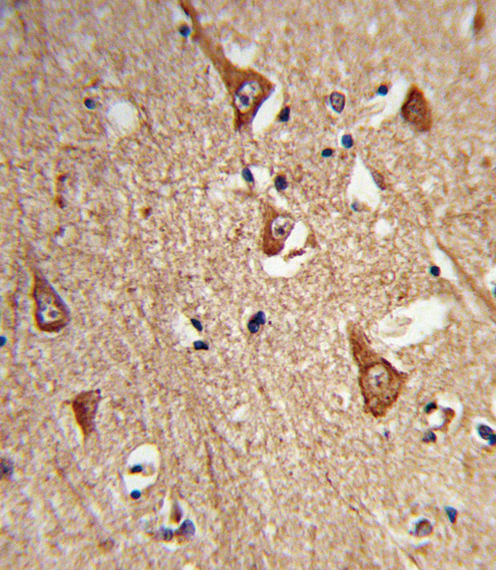CPLX1 Antibody (Center)
Affinity Purified Rabbit Polyclonal Antibody (Pab)
- 产品详情
- 实验流程
- 背景知识
Application
| IHC-P, WB, E |
|---|---|
| Primary Accession | O14810 |
| Other Accession | P63041, P63040, Q4R4N1, Q0IIL7 |
| Reactivity | Human, Mouse |
| Predicted | Bovine, Monkey, Mouse, Rat |
| Host | Rabbit |
| Clonality | Polyclonal |
| Isotype | Rabbit IgG |
| Calculated MW | 15030 Da |
| Antigen Region | 33-60 aa |
| Gene ID | 10815 |
|---|---|
| Other Names | Complexin-1, Complexin I, CPX I, Synaphin-2, CPLX1 |
| Target/Specificity | This CPLX1 antibody is generated from rabbits immunized with a KLH conjugated synthetic peptide between 33-60 amino acids from the Central region of human CPLX1. |
| Dilution | IHC-P~~1:100~500 WB~~1:1000 E~~Use at an assay dependent concentration. |
| Format | Purified polyclonal antibody supplied in PBS with 0.09% (W/V) sodium azide. This antibody is purified through a protein A column, followed by peptide affinity purification. |
| Storage | Maintain refrigerated at 2-8°C for up to 2 weeks. For long term storage store at -20°C in small aliquots to prevent freeze-thaw cycles. |
| Precautions | CPLX1 Antibody (Center) is for research use only and not for use in diagnostic or therapeutic procedures. |
| Name | CPLX1 |
|---|---|
| Function | Positively regulates a late step in exocytosis of various cytoplasmic vesicles, such as synaptic vesicles and other secretory vesicles (PubMed:21785414). Organizes the SNAREs into a cross-linked zigzag topology that, when interposed between the vesicle and plasma membranes, is incompatible with fusion, thereby preventing SNAREs from releasing neurotransmitters until an action potential arrives at the synapse (PubMed:21785414). Also involved in glucose-induced secretion of insulin by pancreatic beta-cells. Essential for motor behavior. |
| Cellular Location | Cytoplasm, cytosol {ECO:0000250|UniProtKB:P63040}. Perikaryon {ECO:0000250|UniProtKB:P63040}. Presynapse {ECO:0000250|UniProtKB:P63040}. Note=Enriched at synaptic-releasing sites in mature neurons. {ECO:0000250|UniProtKB:P63040} |
| Tissue Location | Nervous system. In hippocampus and cerebellum, expressed mainly by inhibitory neurons. Overexpressed in substantia nigra from patients with Parkinson disease |
For Research Use Only. Not For Use In Diagnostic Procedures.
Provided below are standard protocols that you may find useful for product applications.
BACKGROUND
CPLX1 encoded by the complexin/synaphin gene family are cytosolic proteins that function in synaptic vesicle exocytosis. These proteins bind syntaxin, part of the SNAP receptor. The protein product of this gene binds to the SNAP receptor complex and disrupts it, allowing transmitter release.
REFERENCES
Salimi, K., et al. Synapse 62(4):273-282(2008)
Giraudo, C.G., et al. Science 313(5787):676-680(2006)
Kishi, T., et al. Schizophr. Res. 82 (2-3), 185-189 (2006) :
Basso, M., et al. Proteomics 4(12):3943-3952(2004)
Chen, X., et al. Neuron 33(3):397-409(2002)
终于等到您。ABCEPTA(百远生物)抗体产品。
点击下方“我要评价 ”按钮提交您的反馈信息,您的反馈和评价是我们最宝贵的财富之一,
我们将在1-3个工作日内处理您的反馈信息。
如有疑问,联系:0512-88856768 tech-china@abcepta.com.























 癌症的基本特征包括细胞增殖、血管生成、迁移、凋亡逃避机制和细胞永生等。找到癌症发生过程中这些通路的关键标记物和对应的抗体用于检测至关重要。
癌症的基本特征包括细胞增殖、血管生成、迁移、凋亡逃避机制和细胞永生等。找到癌症发生过程中这些通路的关键标记物和对应的抗体用于检测至关重要。 为您推荐一个泛素化位点预测神器——泛素化分析工具,可以为您的蛋白的泛素化位点作出预测和评分。
为您推荐一个泛素化位点预测神器——泛素化分析工具,可以为您的蛋白的泛素化位点作出预测和评分。 细胞自噬受体图形绘图工具为你的蛋白的细胞受体结合位点作出预测和评分,识别结合到自噬通路中的蛋白是非常重要的,便于让我们理解自噬在正常生理、病理过程中的作用,如发育、细胞分化、神经退化性疾病、压力条件下、感染和癌症。
细胞自噬受体图形绘图工具为你的蛋白的细胞受体结合位点作出预测和评分,识别结合到自噬通路中的蛋白是非常重要的,便于让我们理解自噬在正常生理、病理过程中的作用,如发育、细胞分化、神经退化性疾病、压力条件下、感染和癌症。







